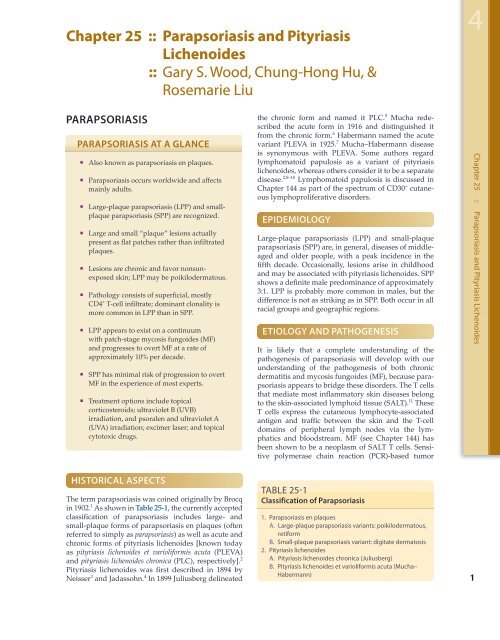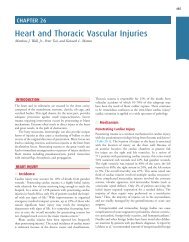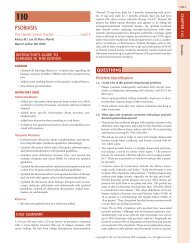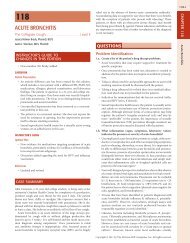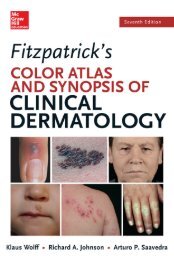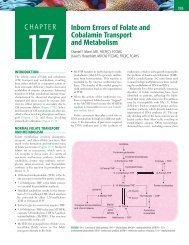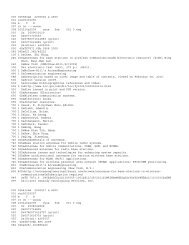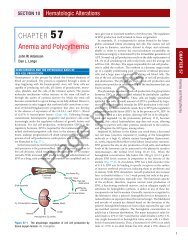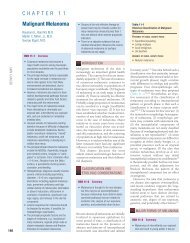Chapter 25 :: Parapsoriasis and Pityriasis Lichenoides :: Gary S ...
Chapter 25 :: Parapsoriasis and Pityriasis Lichenoides :: Gary S ...
Chapter 25 :: Parapsoriasis and Pityriasis Lichenoides :: Gary S ...
You also want an ePaper? Increase the reach of your titles
YUMPU automatically turns print PDFs into web optimized ePapers that Google loves.
<strong>Chapter</strong> <strong>25</strong> :: <strong>Parapsoriasis</strong> <strong>and</strong> <strong>Pityriasis</strong><br />
<strong>Lichenoides</strong><br />
:: <strong>Gary</strong> S. Wood, Chung-Hong Hu, &<br />
Rosemarie Liu<br />
PARAPSORIASIS<br />
PARAPSORIASIS AT A GLANCE<br />
Also known as parapsoriasis en plaques.<br />
<strong>Parapsoriasis</strong> occurs worldwide <strong>and</strong> affects<br />
mainly adults.<br />
Large-plaque parapsoriasis (LPP) <strong>and</strong> smallplaque<br />
parapsoriasis (SPP) are recognized.<br />
Large <strong>and</strong> small “plaque” lesions actually<br />
present as flat patches rather than infiltrated<br />
plaques.<br />
Lesions are chronic <strong>and</strong> favor nonsunexposed<br />
skin; LPP may be poikilodermatous.<br />
Pathology consists of superficial, mostly<br />
CD4 + T-cell infiltrate; dominant clonality is<br />
more common in LPP than in SPP.<br />
LPP appears to exist on a continuum<br />
with patch-stage mycosis fungoides (MF)<br />
<strong>and</strong> progresses to overt MF at a rate of<br />
approximately 10% per decade.<br />
SPP has minimal risk of progression to overt<br />
MF in the experience of most experts.<br />
Treatment options include topical<br />
corticosteroids; ultraviolet B (UVB)<br />
irradiation, <strong>and</strong> psoralen <strong>and</strong> ultraviolet A<br />
(UVA) irradiation; excimer laser; <strong>and</strong> topical<br />
cytotoxic drugs.<br />
HISTORICAL ASPECTS<br />
The term parapsoriasis was coined originally by Brocq<br />
in 1902. 1 As shown in Table <strong>25</strong>-1, the currently accepted<br />
classification of parapsoriasis includes large- <strong>and</strong><br />
small-plaque forms of parapsoriasis en plaques (often<br />
referred to simply as parapsoriasis) as well as acute <strong>and</strong><br />
chronic forms of pityriasis lichenoides [known today<br />
as pityriasis lichenoides et varioliformis acuta (PLEVA)<br />
<strong>and</strong> pityriasis lichenoides chronica (PLC), respectively]. 2<br />
<strong>Pityriasis</strong> lichenoides was first described in 1894 by<br />
Neisser 3 <strong>and</strong> Jadassohn. 4 In 1899 Juliusberg delineated<br />
the chronic form <strong>and</strong> named it PLC. 5 Mucha redescribed<br />
the acute form in 1916 <strong>and</strong> distinguished it<br />
from the chronic form. 6 Habermann named the acute<br />
variant PLEVA in 19<strong>25</strong>. 7 Mucha–Habermann disease<br />
is synonymous with PLEVA. Some authors regard<br />
lymphomatoid papulosis as a variant of pityriasis<br />
lichenoides, whereas others consider it to be a separate<br />
disease. 2,8–10 Lymphomatoid papulosis is discussed in<br />
<strong>Chapter</strong> 144 as part of the spectrum of CD30 + cutaneous<br />
lymphoproliferative disorders.<br />
EPIDEMIOLOGY<br />
Large-plaque parapsoriasis (LPP) <strong>and</strong> small-plaque<br />
parapsoriasis (SPP) are, in general, diseases of middleaged<br />
<strong>and</strong> older people, with a peak incidence in the<br />
fifth decade. Occasionally, lesions arise in childhood<br />
<strong>and</strong> may be associated with pityriasis lichenoides. SPP<br />
shows a definite male predominance of approximately<br />
3:1. LPP is probably more common in males, but the<br />
difference is not as striking as in SPP. Both occur in all<br />
racial groups <strong>and</strong> geographic regions.<br />
ETIOLOGY AND PATHOGENESIS<br />
It is likely that a complete underst<strong>and</strong>ing of the<br />
pathogenesis of parapsoriasis will develop with our<br />
underst<strong>and</strong>ing of the pathogenesis of both chronic<br />
dermatitis <strong>and</strong> mycosis fungoides (MF), because parapsoriasis<br />
appears to bridge these disorders. The T cells<br />
that mediate most inflammatory skin diseases belong<br />
to the skin-associated lymphoid tissue (SALT). 11 These<br />
T cells express the cutaneous lymphocyte-associated<br />
antigen <strong>and</strong> traffic between the skin <strong>and</strong> the T-cell<br />
domains of peripheral lymph nodes via the lymphatics<br />
<strong>and</strong> bloodstream. MF (see <strong>Chapter</strong> 144) has<br />
been shown to be a neoplasm of SALT T cells. Sensitive<br />
polymerase chain reaction (PCR)-based tumor<br />
TABLE <strong>25</strong>-1<br />
Classification of <strong>Parapsoriasis</strong><br />
1. <strong>Parapsoriasis</strong> en plaques<br />
A. Large-plaque parapsoriasis variants: poikilodermatous,<br />
retiform<br />
B. Small-plaque parapsoriasis variant: digitate dermatosis<br />
2. <strong>Pityriasis</strong> lichenoides<br />
A. <strong>Pityriasis</strong> lichenoides chronica (Juliusberg)<br />
B. <strong>Pityriasis</strong> lichenoides et varioliformis acuta (Mucha–<br />
Habermann)<br />
4<br />
1<br />
<strong>Chapter</strong> <strong>25</strong> :: <strong>Parapsoriasis</strong> <strong>and</strong> <strong>Pityriasis</strong> <strong>Lichenoides</strong>
4<br />
Section 4 :: Inflammatory Disorders Based on T-Cell Reactivity <strong>and</strong> Dysregulation<br />
2<br />
clonality assays have underscored the SALT nature of<br />
MF tumor clones by showing that they can continue to<br />
traffic after neoplastic transformation 12 <strong>and</strong> can even<br />
participate in delayed-type hypersensitivity reactions<br />
to contact allergens. 13 This implies that rather than<br />
being a skin lymphoma per se, MF is actually a SALT<br />
lymphoma, i.e., a malignancy of a T-cell circuit rather<br />
than of one particular tissue. Trafficking of MF tumor<br />
cells has been detected even in patients with very early<br />
stage disease whose lesions were consistent clinicopathologically<br />
with LPP. 12,14 Therefore, it can be said<br />
that at least in some cases LPP is a monoclonal proliferation<br />
of SALT T cells that have the capacity to traffic<br />
between the skin <strong>and</strong> extracutaneous sites.<br />
This view is also supported by the presence of structural<br />
<strong>and</strong> numerical chromosomal abnormalities in the<br />
peripheral blood mononuclear cells of patients with<br />
LPP. 15 In this context, LPP can be regarded as the clinically<br />
benign end of the MF disease spectrum, which<br />
eventuates in transformed large cell lymphoma at its<br />
malignant extreme. To say that these diseases belong<br />
to the same disease spectrum is not to say that they<br />
are biologically equivalent disorders. To lump them all<br />
together simply as “MF” would be to ignore their distinctive<br />
clinicopathologic features, which are likely due<br />
to genetic <strong>and</strong>/or epigenetic differences, such as the<br />
p53 gene somatic mutations observed in some cases of<br />
large cell transformation of MF. 16–18 It is likely that several<br />
such differences separate these clinicopathologically<br />
defined disorders in a stepwise fashion analogous<br />
to the sequential acquisition of somatic mutations that<br />
occurs in the colon cancer disease spectrum as colonic<br />
epithelial cells progress through normal, hyperplastic,<br />
in situ carcinoma, invasive carcinoma, <strong>and</strong> metastatic<br />
carcinoma stages. 19,20<br />
A unifying feature of the parapsoriasis group of diseases<br />
is that all of them appear to be cutaneous T-cell<br />
lymphoproliferative disorders: LPP, 12,21–28 SPP, 23,28,29<br />
pityriasis lichenoides, 28,30–32 <strong>and</strong> lymphomatoid papulosis<br />
23,33–35 have all been shown to be monoclonal disorders<br />
in many cases. 36 These relationships suggest<br />
that progression from LPP through the various stages<br />
of the MF disease spectrum is accompanied by an<br />
increasing gradient of dominant T-cell clonal density<br />
resulting from mutations that confer increasing growth<br />
autonomy to the neoplastic T-cell clone. 37 Interestingly,<br />
analysis of peripheral blood has demonstrated that<br />
clonal T cells are often detectable in patients with LPP/<br />
early MF 27,28 or SPP, 28,38 which again supports the systemic<br />
SALT nature of these “primary” skin disorders.<br />
Dominant clonality as seen in the parapsoriasis disease<br />
group, follicular mucinosis, pagetoid reticulosis,<br />
<strong>and</strong> certain other disorders does not equate to clinical<br />
malignancy. In fact, most patients with these diseases<br />
experience a benign clinical course, <strong>and</strong> in some cases<br />
the disease resolves completely. In addition, other<br />
types of chronic cutaneous T-cell infiltrates sometimes<br />
exhibit dominant clonality, including primary (idiopathic)<br />
erythroderma <strong>and</strong> nonspecific chronic spongiotic<br />
dermatitis. This has given rise to the concept of<br />
clonal dermatitis, 14,39 originally described in the context<br />
of clonal nonspecific chronic spongiotic dermatitis<br />
but later exp<strong>and</strong>ed to include other nonlymphomatous<br />
Relationship of clonal dermatitis<br />
to mycosis fungoides (MF)<br />
NCSD<br />
Clonal Dermatitis<br />
LPP MF<br />
PE<br />
FM<br />
Figure <strong>25</strong>-1 The relationship of clonal dermatitis to<br />
mycosis fungoides (MF) <strong>and</strong> various types of chronic<br />
dermatitis. The proportions of each entity that represent<br />
clonal dermatitis <strong>and</strong> mycosis fungoides vary with each<br />
disease <strong>and</strong> are not drawn to scale. FM = follicular mucinosis;<br />
LPP = large-plaque parapsoriasis; NCSD = nonspecific<br />
chronic spongiotic dermatitis; PE = primary erythroderma.<br />
cutaneous T-cell infiltrates that harbor occult monoclonal<br />
T-cell populations. Several cases of clonal dermatitis,<br />
some of which have progressed to MF, have been<br />
identified. 14,21,39 We suspect that for each disease with a<br />
potential for progression to MF, the principal risk may<br />
reside in the subset showing clonal dermatitis, because<br />
this is the subset in which dysregulation has begun to<br />
occur.<br />
The postulated relationships among MF, clonal dermatitis,<br />
<strong>and</strong> selected types of chronic dermatitis are<br />
depicted in Fig. <strong>25</strong>-1. Each of the entities shown is postulated<br />
to be at risk for MF through a clonal dermatitis<br />
intermediate. In this model, MF becomes the final<br />
common pathway for the clonal evolution of neoplastic<br />
T cells emerging from the polyclonal SALT T-cell<br />
populations present in each of the various precursor<br />
diseases.<br />
Various viruses have been proposed to play a role in<br />
the pathogenesis of MF. None has been substantiated<br />
thus far. The most recent virus implicated in both LPP<br />
<strong>and</strong> MF is HHV-8; however, conflicting reports await<br />
resolution. 40–42<br />
CLINICAL FINDINGS<br />
CUTANEOUS LESIONS. LPP lesions are either<br />
oval or irregularly shaped patches or very thin plaques<br />
that are asymptomatic or mildly pruritic. They are usually<br />
well marginated but may also blend imperceptibly<br />
into the surrounding skin. The size is variable, but
Figure <strong>25</strong>-2 Large-plaque parapsoriasis. Irregularly<br />
shaped patches of variable size on the arm of a 16-yearold<br />
girl.<br />
typically most lesions are larger than 5 cm, often measuring<br />
more than 10 cm in diameter. Lesions are stable<br />
in size <strong>and</strong> may increase in number gradually. They are<br />
found mainly on the “bathing trunk” <strong>and</strong> flexural areas<br />
(Fig. <strong>25</strong>-2). Extremities <strong>and</strong> the upper trunk, especially<br />
the breasts in women, also may be involved. They are<br />
light red–brown or salmon pink, <strong>and</strong> their surface is<br />
covered with small <strong>and</strong> scanty scales. Lesions may<br />
appear finely wrinkled—“cigarette paper” wrinkling.<br />
Such lesions exhibit varying degrees of epidermal atrophy.<br />
Telangiectasia <strong>and</strong> mottled pigmentation also<br />
are observed when the atrophy becomes prominent<br />
(Fig. <strong>25</strong>-3). This triad of atrophy, mottled pigmentation,<br />
<strong>and</strong> telangiectasia defines the term poikiloderma<br />
or poikiloderma atrophicans vasculare, which also may be<br />
seen in other conditions (Box <strong>25</strong>-1).<br />
Figure <strong>25</strong>-3 Large-plaque parapsoriasis. Poikilodermatous<br />
variant.<br />
BOX <strong>25</strong>-1 DIFFERENTIAL DIAGNOSIS<br />
OF POIkILODERMA<br />
Large-plaque parapsoriasis<br />
Dermatomyositis<br />
Lupus erythematosus<br />
Chronic radiation dermatitis<br />
Bloom syndrome<br />
Rothmund–Thomson syndrome<br />
Dyskeratosis congenita<br />
Xeroderma pigmentosum<br />
Retiform parapsoriasis refers to a rare variant of LPP<br />
that presents as an extensive eruption of scaly macules<br />
<strong>and</strong> papules in a net-like or zebra-stripe pattern that<br />
eventually becomes poikilodermatous (Fig. <strong>25</strong>-4).<br />
SPP characteristically occurs as round or oval discrete<br />
patches or very thin plaques, mainly on the trunk<br />
(Fig. <strong>25</strong>-5). The lesions measure less than 5 cm in diameter;<br />
they are asymptomatic <strong>and</strong> covered with fine,<br />
moderately adherent scales. The general health of the<br />
patient is unaffected. A distinctive variant with lesions<br />
of a finger shape, known as digitate dermatosis, 43 has<br />
yellowish or fawn-colored lesions (Fig. <strong>25</strong>-6). It follows<br />
lines of cleavage of the skin <strong>and</strong> gives the appearance<br />
of a hug that left fingerprints on the trunk. The long<br />
axis of these lesions often measures greater than 5 cm.<br />
Chronic superficial dermatitis is a synonym for SPP. 44<br />
Figure <strong>25</strong>-4 Large-plaque parapsoriasis. Retiform variant.<br />
4<br />
3<br />
<strong>Chapter</strong> <strong>25</strong> :: <strong>Parapsoriasis</strong> <strong>and</strong> <strong>Pityriasis</strong><strong>Lichenoides</strong>
4<br />
Section 4 :: Inflammatory Disorders Based on T-Cell Reactivity <strong>and</strong> Dysregulation<br />
4<br />
Figure <strong>25</strong>-5 Small-plaque parapsoriasis. Small, discrete<br />
patches less than 5 cm in diameter.<br />
Digitate lesions with a yellow hue were referred to in<br />
the past as xanthoerythrodermia perstans. 2<br />
LABORATORY TESTS<br />
HISTOPATHOLOGY. In early LPP lesions, the epidermis<br />
is mildly acanthotic <strong>and</strong> slightly hyperkeratotic<br />
Figure <strong>25</strong>-6 Small-plaque parapsoriasis. Digitate dermatosis<br />
variant. Typical “fingerprint” patches on the flank.<br />
Note that their length often exceeds 5 cm.<br />
Figure <strong>25</strong>-7 Large-plaque parapsoriasis. Mildly hyperkeratotic<br />
<strong>and</strong> focally parakeratotic epidermis with moderately<br />
dense superficial perivascular infiltrate. Lymphoid cells are<br />
mostly small, cytologically normal lymphocytes, <strong>and</strong> there<br />
is focal single-cell epidermotropism. (Used with permission<br />
from Helmut kerl, MD.)<br />
with spotty parakeratosis. The dermal lymphocytic<br />
infiltrate tends to be perivascular <strong>and</strong> scattered<br />
(Fig. <strong>25</strong>-7). In the more advanced lesions one observes<br />
an interface infiltrate with definite epidermotropism.<br />
These invading lymphocytes may be scattered singly<br />
or in groups, sometimes associated with mild spongiosis.<br />
In addition, the poikilodermatous lesions show<br />
atrophic epidermis, dilated blood vessels, <strong>and</strong> melanophages<br />
(Fig. <strong>25</strong>-8). Immunohistologic studies have revealed<br />
similar features in LPP <strong>and</strong> early MF, including<br />
a predominance of CD4 + T-cell subsets, frequent CD7<br />
antigen deficiency, <strong>and</strong> widespread epidermal expression<br />
of class II HLA (HLA-DR). 22–24,45–48<br />
SPP exhibits mild spongiotic dermatitis with focal<br />
areas of hyperkeratosis, parakeratosis, scale crust, <strong>and</strong><br />
exocytosis. In the dermis, there is a mild superficial<br />
perivascular lymphohistiocytic infiltrate <strong>and</strong> dermal<br />
edema (Fig. <strong>25</strong>-9). There is no progression of the histologic<br />
features with time. Immunohistologic studies<br />
reveal a predominantly CD4 + T-cell infiltrate with<br />
nonspecific features resembling those seen in various<br />
types of dermatitides. 47<br />
Figure <strong>25</strong>-8 Large-plaque parapsoriasis. Atrophic variant.<br />
Sparse superficial lymphoid infiltrate with mild epidermotropism<br />
<strong>and</strong> epidermal atrophy.
Figure <strong>25</strong>-9 Small-plaque parapsoriasis. Superficial perivascular<br />
lymphoid infiltrate, mild spongiosis, parakeratosis,<br />
<strong>and</strong> focal scale crust.<br />
DIAGNOSIS AND<br />
DIFFERENTIAL DIAGNOSIS<br />
LPP is distinguished from SPP by the larger size, asymmetric<br />
distribution, <strong>and</strong> irregular shape of its lesions,<br />
which are less discrete <strong>and</strong> often poikilodermatous.<br />
LPP may be clinically <strong>and</strong> histopathologically indistinguishable<br />
from the patch stage of MF. Both LPP <strong>and</strong><br />
SPP are readily distinguished from more advanced<br />
infiltrated plaques of MF because parapsoriasis lesions<br />
are, by definition, not thicker than patches or at most<br />
very thin plaques. This is so because the English equivalent<br />
of the French term plaques is patches, i.e., lesions<br />
that are essentially flat <strong>and</strong> devoid of induration<br />
or palpable infiltration. 49 Failure to appreciate this<br />
important distinction has led to considerable confusion<br />
<strong>and</strong> misuse of the terms large-plaque parapsoriasis <strong>and</strong><br />
small-plaque parapsoriasis by some individuals. These<br />
designations more appropriately might be thought of<br />
as large-patch parapsoriasis <strong>and</strong> small-patch parapsoriasis.<br />
The degree to which LPP is differentiated from early<br />
MF depends primarily on the histopathologic criteria<br />
used to diagnose the latter disorder. Unfortunately,<br />
there are no universally accepted minimal criteria for<br />
the diagnosis of MF; however, one set proposed by<br />
the International Society for Cutaneous Lymphoma is<br />
presented in Table <strong>25</strong>-2. 50 This algorithm is based on a<br />
holistic integration of clinical, histopathologic, immunopathologic,<br />
<strong>and</strong> clonality data. It differs significantly<br />
from many prior approaches because it does not rely<br />
solely on histopathologic features. 51 Assuming that<br />
histopathologic examination does not disclose features<br />
diagnostic of some other dermatosis, these criteria<br />
allow lesions to be classified as either patch-stage MF<br />
or not. For the practical purposes of clinical management,<br />
patients presenting clinically with patch lesions<br />
whose features result in a score of four points or more<br />
are considered to have unequivocal MF. Obviously,<br />
the more liberal the criteria, the more cases could be<br />
considered to be MF. However, there will always be<br />
some cases that fail to meet any specific set of criteria,<br />
<strong>and</strong> the designation LPP is a useful term to apply to<br />
them because it guides treatment <strong>and</strong> follow-up <strong>and</strong><br />
conveys an underst<strong>and</strong>ing that the risk of dying from<br />
lymphoma is small.<br />
The clinical <strong>and</strong>/or histopathologic differential<br />
diagnosis of LPP also includes those collagen vascular<br />
diseases <strong>and</strong> genodermatoses exhibiting poikilodermatous<br />
features, lichenoid drug eruptions, secondary<br />
syphilis, chronic radiodermatitis, <strong>and</strong> occasionally<br />
TABLE <strong>25</strong>-2<br />
Algorithm for the Diagnosis of Patch-Stage Mycosis Fungoides (Four Points are Required)<br />
Parameter 2 Points 1 Point<br />
Clinical:<br />
Persistent, progressive patches <strong>and</strong> plaques ±<br />
Nonsun-exposed distribution<br />
Variation in size <strong>and</strong> shape<br />
Poikiloderma<br />
Histopathologic:<br />
Superficial dermal T-cell infiltrate ±<br />
Epidermotropism<br />
Nuclear atypia<br />
Immunopathologic:<br />
CD2, CD3, or CD5
4<br />
Section 4 :: Inflammatory Disorders Based on T-Cell Reactivity <strong>and</strong> Dysregulation<br />
6<br />
BOX <strong>25</strong>-2 DIFFERENTIAL DIAGNOSIS<br />
OF LARGE-PLAqUE PARAPSORIASIS<br />
(LPP) AND SMALL-PLAqUE<br />
PARAPSORIASIS (SPP)<br />
Most Likely<br />
LPP<br />
Tinea corporis<br />
Plaque-type psoriasis<br />
Contact dermatitis<br />
Subacute cutaneous lupus erythematosus<br />
SPP<br />
Nummular dermatitis<br />
<strong>Pityriasis</strong> rosea<br />
Plaque <strong>and</strong> guttate psoriasis<br />
Pigmented purpuric dermatoses<br />
<strong>Pityriasis</strong> lichenoides chronica<br />
Consider<br />
LPP<br />
Xerotic dermatitis<br />
Atopic dermatitis<br />
Dermatomyositis<br />
Drug eruption<br />
Erythema dyschromicum perstans<br />
Pigmented purpuric dermatoses<br />
Early inflammatory morphea<br />
Atrophoderma of Pasini–Pierini<br />
Erythema annulare centrifugum<br />
<strong>Pityriasis</strong> rubra pilaris<br />
Genodermatoses with poikiloderma<br />
Chronic radiodermatitis<br />
SPP<br />
Tinea versicolor<br />
Seborrheic dermatitis<br />
Drug eruption<br />
Always Rule Out<br />
LPP<br />
Mycosis fungoides<br />
SPP<br />
Mycosis fungoides<br />
Secondary syphilis<br />
several other diseases tabulated in Box <strong>25</strong>-2. These generally<br />
can be distinguished by their associated clinical<br />
findings. Histopathologic differentiation among these<br />
diseases is covered largely in the discussion of pseudo-<br />
MF in <strong>Chapter</strong> 145.<br />
SPP, when it presents with its distinctive digitate<br />
dermatosis lesions parallel to skin lines in a truncal<br />
distribution, st<strong>and</strong>s out from other types of parapsoriasis.<br />
Individual SPP lesions may show some superficial<br />
resemblance to PLC. SPP is distinguished from<br />
psoriasis by the absence of the Auspitz sign (see <strong>Chapter</strong><br />
17), micaceous scale, nail pits, <strong>and</strong> typical psoriatic<br />
lesions involving the scalp, elbows, <strong>and</strong> knees. Histologically,<br />
its mild spongiotic dermatitis <strong>and</strong> absence of<br />
other characteristic features distinguish it from PLC,<br />
psoriasis, <strong>and</strong> several of the other entities listed in<br />
Box <strong>25</strong>-2. Clinical features are also important, such as<br />
the herald patch of pityriasis rosea <strong>and</strong> the papulovesicular<br />
coin-shaped patches favoring the lower extremities<br />
in nummular dermatitis.<br />
Sometimes patients with MF may exhibit small<br />
patches of disease at presentation; however, these<br />
lesions typically have histopathologic features at<br />
least consistent with MF <strong>and</strong> generally are associated<br />
with larger, more classic lesions of MF elsewhere on<br />
the skin. They also may show poikilodermatous features<br />
not seen in SPP. Furthermore, the presence of<br />
well-developed, moderate to thick small plaques, as<br />
seen in some MF patients, is incompatible with the<br />
diagnosis of SPP because the latter disorder includes<br />
only lesions that are no more than patches or very<br />
thin plaques. It is also important to recognize that<br />
partially treated or early relapsing lesions of MF may<br />
show only nonspecific features that should not be<br />
taken as evidence of a pathogenetic link to SPP or any<br />
other dermatosis.<br />
COMPLICATIONS<br />
LPP can be associated with other forms of parapsoriasis<br />
<strong>and</strong> overt cutaneous lymphomas as detailed elsewhere<br />
in this chapter. Both LPP <strong>and</strong> SPP occasionally<br />
can develop areas of impetiginization secondary to<br />
excoriation.<br />
PROGNOSIS AND CLINICAL COURSE<br />
Both LPP <strong>and</strong> SPP may persist for years to decades<br />
with little change in appearance clinically or histopathologically.<br />
Approximately 10% to 30% of cases of LPP<br />
progress to overt MF. 2,52–54 In this context, LPP represents<br />
the clinically benign end of the MF disease spectrum,<br />
with transformation to large cell lymphoma at<br />
the opposite extreme. The rare retiform variant is said<br />
to progress to overt MF in virtually all cases. 2<br />
In contrast to LPP with its malignant potential, SPP<br />
is a clinically benign disorder in the experience of<br />
most experts. Patients with this disease as defined in<br />
this chapter rarely develop overt MF. 11,44,55,56 Despite<br />
this fact <strong>and</strong> what most observers consider to be its<br />
nonspecific histopathologic features, some authors<br />
favor lumping SPP within the MF disease spectrum<br />
as a very early, nonprogressive variant. 55,57 This issue<br />
has been debated at length. 31,57,58 A few studies report<br />
progression from SPP to MF in about 10% of cases but<br />
may have used different criteria than described in this<br />
chapter. 53,54<br />
TREATMENT<br />
Patients with SPP should be reassured <strong>and</strong> may forego<br />
treatment. The disease may be treated with emollients,
BOX <strong>25</strong>-3 TREATMENT OF LARGE-<br />
PLAqUE PARAPSORIASIS AND<br />
SMALL-PLAqUE PARAPSORIASIS<br />
FIRST LINE<br />
Emollients<br />
Topical corticosteroids<br />
Topical tar products<br />
Sunbathing<br />
Broadb<strong>and</strong> UVB phototherapy<br />
Narrowb<strong>and</strong> UVB phototherapy<br />
SECOND LINE<br />
(Mainly for large-plaque parapsoriasis cases considered<br />
to be early mycosis fungoides)<br />
Topical bexarotene<br />
Topical imiquimod<br />
Psoralen <strong>and</strong> UVA phototherapy<br />
Topical mechlorethamine<br />
Topical carmustine (BCNU)<br />
Excimer laser (308 nm)<br />
topical tar preparations, topical corticosteroids, <strong>and</strong>/<br />
or broadb<strong>and</strong> or narrowb<strong>and</strong> UVB phototherapy<br />
(Box <strong>25</strong>-3). 59 Response to therapy is variable. Patients<br />
should initially be examined every 3 to 6 months <strong>and</strong><br />
subsequently every year to ensure that the character of<br />
the process is stable.<br />
LPP requires more aggressive therapy: highpotency<br />
topical corticosteroids with phototherapy<br />
such as broadb<strong>and</strong> UVB, narrowb<strong>and</strong> UVB, or psoralen<br />
<strong>and</strong> UVA (PUVA). The goal of treatment is to<br />
suppress the disorder to prevent possible progression<br />
to overt MF. Other methods of treatment, such<br />
as topical nitrogen mustard, have been used, particularly<br />
for the poikilodermatous type. Localized lesions<br />
may respond to excimer laser (308 nm). 60,61 The<br />
patient should be examined carefully every 3 months<br />
initially <strong>and</strong> every 6 months to 1 year subsequently<br />
for evidence of progression. Repeated multiple biopsies<br />
of suspicious lesions should be performed. Cases<br />
that satisfy the clinicopathologic criteria for early MF<br />
can be treated with broadb<strong>and</strong> UVB, narrowb<strong>and</strong><br />
UVB, PUVA, topical nitrogen mustard, topical bexarotene<br />
gel, topical imiquimod, or topical carmustine<br />
(BCNU). 62 Electron-beam radiation therapy generally<br />
is reserved for more advanced, infiltrated lesions of<br />
MF.<br />
PREVENTION<br />
Because LPP <strong>and</strong> SPP are uncommon diseases that<br />
appear to affect patients r<strong>and</strong>omly, there are no known<br />
preventive measures.<br />
PITYRIASIS LICHENOIDES<br />
PITYRIASIS LICHENOIDES<br />
AT A GLANCE<br />
<strong>Pityriasis</strong> lichenoides et varioliformis acuta<br />
(PLEVA) <strong>and</strong> pityriasis lichenoides chronica<br />
(PLC) represent two ends of a disease<br />
spectrum; both entities <strong>and</strong> intermediate<br />
forms can coexist.<br />
All forms are characterized by spontaneously<br />
resolving, temporally overlapping crops of<br />
papules.<br />
PLEVA papules last for weeks <strong>and</strong> may<br />
develop crusts, vesicles, pustules, or ulcers.<br />
PLC papules persist for months <strong>and</strong> develop<br />
scales.<br />
All forms contain interface, cytolytic<br />
T-cell infiltrates with variable epidermal<br />
destruction.<br />
In PLEVA, CD8 + cells predominate.<br />
In PLC, CD8 + or CD4 + cells predominate.<br />
Dominant T-cell clonality can be detected in<br />
all forms, more often in PLEVA than in PLC.<br />
Treatment depends on severity <strong>and</strong> ranges<br />
from topical steroids, systemic antibiotics,<br />
UV irradiation, <strong>and</strong> psoralen <strong>and</strong> UVA to<br />
systemic immunosuppressants.<br />
EPIDEMIOLOGY<br />
<strong>Pityriasis</strong> lichenoides affects all racial <strong>and</strong> ethnic<br />
groups in all geographic regions. 63–68 It is more common<br />
in children <strong>and</strong> young adults but can affect all<br />
ages with seasonal variation in onset favoring fall <strong>and</strong><br />
winter. There is a male predominance of 1.5:1 to 3:1.<br />
PLC is three to six times more common than PLEVA.<br />
ETIOLOGY AND PATHOGENESIS<br />
The etiology of pityriasis lichenoides is unknown.<br />
Some cases have been associated with infectious<br />
agents such as Toxoplasma gondii, 69,70 Epstein-Barr<br />
virus, 70,71 cytomegalovirus, 70,71 parvovirus B19, 70,72,73<br />
<strong>and</strong> human immunodeficiency virus. 74,75 At least one<br />
case was linked repeatedly with estrogen–progesterone<br />
therapy, another with chemotherapy drugs, <strong>and</strong><br />
a third with radiocontrast iodide. 76–78 It is uncertain<br />
4<br />
7<br />
<strong>Chapter</strong> <strong>25</strong> :: <strong>Parapsoriasis</strong> <strong>and</strong> <strong>Pityriasis</strong><strong>Lichenoides</strong>
4<br />
Section 4 :: Inflammatory Disorders Based on T-Cell Reactivity <strong>and</strong> Dysregulation<br />
8<br />
whether these agents are actively involved in disease<br />
pathogenesis or merely coincidental byst<strong>and</strong>ers; however,<br />
several cases associated with toxoplasmosis have<br />
cleared fairly quickly in response to specific therapy. 69<br />
A tenfold higher level of maternal keratinocytes have<br />
been reported in the epidermis of children with PL<br />
compared to controls. 79<br />
Immunohistologic studies have shown a reduction in<br />
CD1a + antigen-presenting dendritic (Langerhans) cells<br />
within the central epidermis of pityriasis lichenoides<br />
lesions. 80 Keratinocytes <strong>and</strong> endothelial cells are HLA-<br />
DR + , which suggests activation by T-cell cytokines. 80<br />
CD8 + T cells predominate in PLEVA, whereas either<br />
CD8 + or CD4 + T cells predominate in PLC. 80–82 Many<br />
of these T cells express memory proteins (CD45RO)<br />
<strong>and</strong> cytolytic proteins (TIA-1 <strong>and</strong> granzyme B). 72,73<br />
Dominant T-cell clonality has been demonstrated<br />
in about half of PLEVA cases <strong>and</strong> a minority of PLC<br />
cases. 32,83,84 In aggregate, these findings raise the possibility<br />
that pityriasis lichenoides is a variably clonal<br />
cytolytic memory T-cell lymphoproliferative response<br />
to one or more foreign antigens. Deposition of immunoglobulin<br />
M, C3, <strong>and</strong> fibrin in <strong>and</strong> around blood vessels<br />
<strong>and</strong> along the dermal–epidermal junction in early<br />
acute lesions suggests a possible concomitant humoral<br />
immune response, although this could be a secondary<br />
phenomenon.<br />
The relationship of pityriasis lichenoides to lymphomatoid<br />
papulosis remains controversial 10,51,80 (see<br />
also <strong>Chapter</strong>s 144 <strong>and</strong> 145). Common features include<br />
dominant T-cell clonality <strong>and</strong> spontaneous resolution<br />
of papular, predominantly lymphoid lesions. Furthermore,<br />
individual lesions with the clinicopathologic<br />
characteristics of either pityriasis lichenoides or lymphomatoid<br />
papulosis can coexist in the same patient,<br />
either concurrently or serially. It remains to be determined<br />
whether this can be explained as an artifact of<br />
sampling lymphomatoid papulosis lesions at various<br />
stages of their evolution. The presence of large CD30 +<br />
atypical lymphoid cells is the hallmark of lymphomatoid<br />
papulosis (at least types A <strong>and</strong> C). 84 Furthermore,<br />
these cells are typically CD4 + <strong>and</strong> often lack one or<br />
more mature T-cell antigens such as CD2, CD3, <strong>and</strong><br />
CD5. These features serve to distinguish lymphomatoid<br />
papulosis from pityriasis lichenoides. Although<br />
occasional CD30 + cells can be seen in a wide variety<br />
of dermatoses, the presence of any appreciable number<br />
should favor lymphomatoid papulosis over pityriasis<br />
lichenoides as a matter of definition. It may be<br />
that the “PLC-PLEVA” <strong>and</strong> “lymphomatoid papulosis–CD30<br />
+ anaplastic large cell lymphoma” disease<br />
spectra are intersecting rather than overlapping entities,<br />
i.e., although pityriasis lichenoides is a distinct<br />
cutaneous T-cell disorder, it is possible that it may<br />
sometimes serve as fertile soil for the development of<br />
the CD30 + T-cell clone characteristic of lymphomatoid<br />
papulosis.<br />
CLINICAL FINDINGS<br />
CUTANEOUS LESIONS. PLC <strong>and</strong> PLEVA exist<br />
on a clinicopathologic continuum. 2,51 Therefore,<br />
Figure <strong>25</strong>-10 <strong>Pityriasis</strong> lichenoides chronica. Polymorphous<br />
appearance ranging from early erythematous<br />
papules to scaling brown–red lesions <strong>and</strong> tan-brown involuting,<br />
flat papules, <strong>and</strong> macules.<br />
individual patients may exhibit a mixture of acute <strong>and</strong><br />
chronic lesions sequentially or concurrently. In addition,<br />
lesions representing clinical or histopathologic<br />
intergrades between the extremes may also occur at<br />
any time.<br />
Lesions are often asymptomatic but can be pruritic<br />
or burning, especially in the more acute cases. PLC<br />
typically presents as recurrent crops of erythematous<br />
scaly papules that spontaneously regress over<br />
several weeks to months (Fig. <strong>25</strong>-10). PLEVA manifests<br />
as recurrent crops of erythematous papules<br />
that develop crusts, vesicles, pustules, or erosions<br />
before spontaneously regressing within a matter of<br />
weeks (Fig. <strong>25</strong>-11). The more severe ulcerative variant<br />
is known as pityriasis lichenoides with ulceronecrosis<br />
<strong>and</strong> hyperthermia (PLUH) or febrile ulceronecrotic<br />
Mucha–Habermann disease (FUMHD). 85<br />
It presents<br />
as purpuric papulonodules with central ulcers up<br />
to a few centimeters in diameter (Fig. <strong>25</strong>-12). Some<br />
have proposed that this severe variant is actually<br />
an overt T-cell lymphoma. 31 <strong>Pityriasis</strong> lichenoides<br />
lesions tend to concentrate on the trunk <strong>and</strong><br />
proximal extremities, but any region of the skin <strong>and</strong><br />
even mucous membranes can be involved. Rare<br />
regional or segmental lesion distributions have<br />
been described, 10,86 as has rare conjunctival nodular<br />
inflammation. 87 Although there are usually numerous<br />
coexistent lesions, occasionally only a small<br />
number of lesions will be present at any one time.<br />
All forms of pityriasis lichenoides can result in
A B<br />
C<br />
postinflammatory hypopigmentation or hyperpigmentation.<br />
63 Chronic lesions can resolve with postinflammatory<br />
hypopigmentation, sometimes presenting<br />
as idiopathic guttate hypomelanosis. Chronic lesions<br />
Figure <strong>25</strong>-12 <strong>Pityriasis</strong> lichenoides, ulceronecrotic, hyperacute<br />
variant. Large necrotic eschar with halo erythema<br />
developing in febrile patient with antecedent pityriasis lichenoides<br />
et varioliformis acuta.<br />
Figure <strong>25</strong>-11 <strong>Pityriasis</strong> lichenoides et varioliformis acuta.<br />
A. Adolescent with multiple erythematous papules <strong>and</strong><br />
crusted lesions in various stages of evolution. B. Larger<br />
papulovesicular <strong>and</strong> hemorrhagic, crusted lesions in an<br />
adult. Note varioliform scars adjacent to active lesions on<br />
posterior thigh <strong>and</strong> leg. C. Pustules, crusts, <strong>and</strong> necroticcentered<br />
papules with erythematous, indurated base.<br />
rarely lead to scars. In contrast, acute lesions result in<br />
deeper dermal injury <strong>and</strong> consequently often resolve<br />
leaving varioliform (smallpox-like) scars. The presence<br />
of lesions in various stages of evolution imparts<br />
a polymorphous appearance that is characteristic of<br />
pityriasis lichenoides.<br />
LABORATORY TESTS<br />
Miscellaneous nonspecific abnormalities in blood test<br />
results occur but are of little practical value. Leukocytosis<br />
<strong>and</strong> a decreased CD4/CD8 ratio can occur.<br />
HISTOPATHOLOGY. As with the morphology<br />
of the clinical lesions, pityriasis lichenoides can<br />
exhibit a range of histopathologic features encompassing<br />
acute, chronic, <strong>and</strong> intermediate lesional<br />
variants (Figs. <strong>25</strong>-13 <strong>and</strong> <strong>25</strong>-14). All cases of pityriasis<br />
lichenoides contain an interface dermatitis<br />
that is denser <strong>and</strong> more wedge shaped in the acute<br />
lesions. The infiltrate is composed mainly of lymphocytes<br />
with a variable admixture of neutrophils<br />
<strong>and</strong> histiocytes. There is exocytosis, parakeratosis,<br />
<strong>and</strong> extravasation of erythrocytes. Epidermal damage<br />
ranges from intercellular <strong>and</strong> extracellular edema<br />
in less severe cases to extensive keratinocyte<br />
necrosis, vesicles, pustules, <strong>and</strong> ulcers. The acute<br />
variants can exhibit lymphocytic vasculitis with fibrinoid<br />
degeneration of blood vessel walls.<br />
4<br />
9<br />
<strong>Chapter</strong> <strong>25</strong> :: <strong>Parapsoriasis</strong> <strong>and</strong> <strong>Pityriasis</strong><strong>Lichenoides</strong>
4<br />
Section 4 :: Inflammatory Disorders Based on T-Cell Reactivity <strong>and</strong> Dysregulation<br />
10<br />
A B<br />
Figure <strong>25</strong>-13 <strong>Pityriasis</strong> lichenoides et varioliformis acuta. A. Ulcerated papule with epidermal necrosis, hemorrhage, <strong>and</strong><br />
superficial <strong>and</strong> deep perivascular lymphocytic infiltrate. Hematoxylin <strong>and</strong> eosin (H&E) stain. B. Parakeratosis <strong>and</strong> crust with<br />
marked spongiosis <strong>and</strong> epidermal necrosis. Lymphocyte exocytosis <strong>and</strong> basal hydropic changes. H&E stain.<br />
Occasional CD30 + lymphoid cells <strong>and</strong> occasional<br />
atypical lymphoid cells may be seen as a nonspecific<br />
finding in many cutaneous lymphoid infiltrates. The<br />
presence of an appreciable numbers of these cells is<br />
not consistent with classic pityriasis lichenoides of any<br />
type <strong>and</strong> should raise concern for the lymphomatoid<br />
papulosis–CD30 + anaplastic large cell lymphoma disease<br />
spectrum. 30 Other immunohistologic features <strong>and</strong><br />
the clonality of pityriasis lichenoides are discussed<br />
in section “Etiology <strong>and</strong> Pathogenesis” under section<br />
“<strong>Pityriasis</strong> <strong>Lichenoides</strong>.”<br />
DIFFERENTIAL DIAGNOSIS<br />
The differential diagnosis of pityriasis lichenoides<br />
includes many papular eruptions (Box <strong>25</strong>-4). Those<br />
that develop crusts, vesicles, pustules, or ulcers are<br />
grouped with PLEVA, whereas those that form predominantly<br />
scaly papules are grouped with PLC.<br />
Most of them can be excluded based on history <strong>and</strong><br />
typical clinicopathologic features. A few, such as<br />
A B<br />
secondary syphilis <strong>and</strong> virus-associated lesions, can<br />
also be excluded based on serologic tests. Among the<br />
most challenging diseases to distinguish from pityriasis<br />
lichenoides are lymphomatoid papulosis <strong>and</strong><br />
macular or papular variants of MF. 88–91 As detailed<br />
earlier, the presence of large atypical lymphoid cells<br />
(often CD30 + ) differentiates lymphomatoid papulosis<br />
from pityriasis lichenoides. 84 Macular or papular<br />
variants of MF are rare. They exhibit classic histopathological<br />
features of MF, including small atypical<br />
epidermotropic lymphoid cells with convoluted<br />
nuclei <strong>and</strong> a b<strong>and</strong>-like superficial dermal lymphoid<br />
infiltrate. 90<br />
COMPLICATIONS<br />
Secondary infection is the most common complication<br />
of pityriasis lichenoides. PLEVA may be associated<br />
with low-grade fever, malaise, headache, <strong>and</strong> arthralgia.<br />
Patients with PLUH/FUMHD can develop high<br />
fever, malaise, myalgia, arthralgia, <strong>and</strong> gastrointestinal<br />
Figure <strong>25</strong>-14 <strong>Pityriasis</strong> lichenoides chronica. A. Compact parakeratosis, lymphocytic exocytosis, occasional eosinophilic<br />
necrotic keratinocytes, edema, <strong>and</strong> diffuse lymphocytic infiltrate localizing to epidermal–dermal interface <strong>and</strong> perivascular<br />
sites within the dermis. Hematoxylin <strong>and</strong> eosin (H&E) stain. B. Parakeratosis, spongiosis, <strong>and</strong> a predominant mononuclear<br />
cell infiltrate in the epidermis <strong>and</strong> dermis with papillary edema. H&E stain.
BOX <strong>25</strong>-4 DIFFERENTIAL DIAGNOSIS<br />
OF PITYRIASIS LICHENOIDES ET<br />
VARIOLIFORMIS ACUTA (PLEVA)<br />
AND PITYRIASIS LICHENOIDES<br />
CHRONICA (PLC)<br />
Most Likely<br />
PLEVA<br />
Arthropod bites, stings, infestations<br />
Leukocytoclastic vasculitis<br />
Viral exanthem (e.g., varicella-zoster, herpes<br />
simplex)<br />
PLC<br />
<strong>Pityriasis</strong> rosea<br />
Drug eruption<br />
Guttate psoriasis<br />
Consider<br />
PLEVA<br />
Folliculitis<br />
Rickettsiosis<br />
Erythema multiforme<br />
Dermatitis herpetiformis<br />
PLC<br />
Spongiotic dermatitis, papular variant<br />
Small-plaque parapsoriasis<br />
Lichen planus<br />
Gianotti–Crosti syndrome<br />
Always Rule Out<br />
PLEVA<br />
Lymphomatoid papulosis<br />
Secondary syphilis<br />
PLC<br />
Lymphomatoid papulosis<br />
Mycosis fungoides (papular variant)<br />
Secondary syphilis<br />
<strong>and</strong> central nervous system symptoms. Occasionally,<br />
debilitated patients may die. 85,92 PLC has been associated<br />
uncommonly with LPP in children. 44 Despite<br />
their sometimes dominant T-cell clonal nature, PLC<br />
<strong>and</strong> PLEVA are considered clinically benign disorders<br />
without significant linkage to lymphomas or other<br />
malignancies.<br />
PROGNOSIS AND CLINICAL COURSE<br />
<strong>Pityriasis</strong> lichenoides has a variable clinical course<br />
characterized by recurrent crops of lesions that spontaneously<br />
resolve. The disorder may resolve spontaneously<br />
within a few months or, less commonly,<br />
persist for years. PLEVA usually has a shorter duration<br />
than PLC. Although the conclusion was not<br />
confirmed by subsequent investigation, one report<br />
suggested that the duration of pityriasis lichenoides<br />
in children correlated better with its clinical distribution<br />
than with the relative abundance of acute <strong>and</strong><br />
chronic lesions, which often coexisted. 67 From longest<br />
to shortest duration, the distribution of lesions<br />
ranged from peripheral (distal extremities) to central<br />
(trunk) to diffuse.<br />
TREATMENT<br />
The mainstay of traditional therapy has been a combination<br />
of topical corticosteroids <strong>and</strong> phototherapy<br />
(Box <strong>25</strong>-5). Systemic antibiotics in the tetracycline <strong>and</strong><br />
erythromycin families are used primarily for their antiinflammatory<br />
rather than antibiotic effects. One newer<br />
option is azithromycin. 93 Cases with minimal disease<br />
activity may not require any treatment. Photodynamic<br />
therapy has been used successfully for PLC. 94 The more<br />
acute the clinical course <strong>and</strong> the more severe the individual<br />
lesions, the more systemic therapy is indicated.<br />
Methotrexate is often effective in relatively low doses.<br />
Calcineurin inhibitors <strong>and</strong> retinoids may also be beneficial.<br />
Severe cases of PLEVA <strong>and</strong> PLUH often require<br />
systemic corticosteroids or similar drugs to gain control<br />
of systemic symptoms. Topical <strong>and</strong> systemic antibiotics<br />
may be needed to treat secondary infections<br />
complicating ulcerated skin lesions. These agents are<br />
often selected initially to cover Gram-positive pathogens,<br />
but subsequent use should be guided by culture<br />
results. Bromelain, a pineapple extract, cleared PLC<br />
lesions in 8/8 cases. 95<br />
BOX <strong>25</strong>-5 TREATMENT OF PITYRIASIS<br />
LICHENOIDES ET VARIOLIFORMIS ACUTA<br />
AND PITYRIASIS LICHENOIDES CHRONICA<br />
FIRST LINE<br />
Topical corticosteroids<br />
Antibiotics (erythromycin 500 mg PO 2–4 × daily 96 ;<br />
tetracycline 500 mg PO 2–4 × daily, 97 minocycline<br />
100 mg PO twice daily; azithromycin 500 mg PO on<br />
day 1 <strong>and</strong> <strong>25</strong>0 mg PO on days 2–5 bimonthly93 )<br />
Phototherapy (sunbathing, UVB, 90 UVA + UVB, 98<br />
narrowb<strong>and</strong> UVB99 )<br />
SECOND LINE<br />
Topical tacrolimus100,101 Prednisone (60/40/20 mg PO taper, 5 days each) 102<br />
Methotrexate (10–<strong>25</strong> mg PO weekly) 103,104<br />
Phototherapy (UVAI, psoralen + UVA)<br />
Cyclosporine (2.5–4 mg/kg/day total dose divided<br />
into twice-daily PO doses; use the minimum) 75<br />
Retinoids (e.g., acitretin <strong>25</strong>–50 mg PO daily) 105<br />
Photodynamic therapy94 Bromelain (pineapple extract) 95<br />
4<br />
<strong>Chapter</strong> <strong>25</strong> :: <strong>Parapsoriasis</strong> <strong>and</strong> <strong>Pityriasis</strong><strong>Lichenoides</strong><br />
11
4<br />
Section 4 :: Inflammatory Disorders Based on T-Cell Reactivity <strong>and</strong> Dysregulation<br />
12<br />
PREVENTION<br />
There are no known preventive measures.<br />
KEY REFERENCES<br />
Full reference list available at www.DIGM8.com<br />
2. Lambert WC, Everett MA: The nosology of parapsoriasis.<br />
J Am Acad Dermatol 5(4):373-395, 1981<br />
39. Wood GS et al: Detection of clonal T-cell receptor gamma<br />
gene rearrangements in early mycosis fungoides/Sezary<br />
syndrome by polymerase chain reaction <strong>and</strong> denaturing<br />
gradient gel electrophoresis (PCR/DGGE). J Invest Dermatol<br />
103(1):34-41, 1994<br />
43. Hu CH, Winkelmann RK: Digitate dermatosis. A new look<br />
at symmetrical, small plaque parapsoriasis. Arch Dermatol<br />
107(1):65-69, 1973<br />
44. Samman PD: The natural history of parapsoriasis en<br />
plaques (chronic superficial dermatitis) <strong>and</strong> prereticulotic<br />
poikiloderma. Br J Dermatol 87(5):405-411, 1972<br />
50. Pimpinelli N et al: Defining early mycosis fungoides. J Am<br />
Acad Dermatol 53(6):1053-1063, 2005<br />
53. Vakeva L et al: A retrospective study of the probability<br />
of the evolution of parapsoriasis en plaques into mycosis<br />
fungoides. Acta Derm Venereol 85(4):318-323, 2005<br />
64. Bowers S, Warshaw EM: <strong>Pityriasis</strong> lichenoides <strong>and</strong> its<br />
subtypes. J Am Acad Dermatol 55(4):557-572, 2006; quiz<br />
573-556<br />
65. Ersoy-Evans S et al: <strong>Pityriasis</strong> lichenoides in childhood:<br />
a retrospective review of 124 patients. J Am Acad Dermatol<br />
56(2):205-210, 2007<br />
66. Khachemoune A, Blyumin ML: <strong>Pityriasis</strong> lichenoides:<br />
pathophysiology, classification, <strong>and</strong> treatment. Am J Clin<br />
Dermatol 8(1):29-36, 2007<br />
85. Sotiriou E et al: Febrile ulceronecrotic Mucha-Habermann<br />
disease: A case report <strong>and</strong> review of the literature. Acta<br />
Derm Venereol 88(4):350-355, 2008


